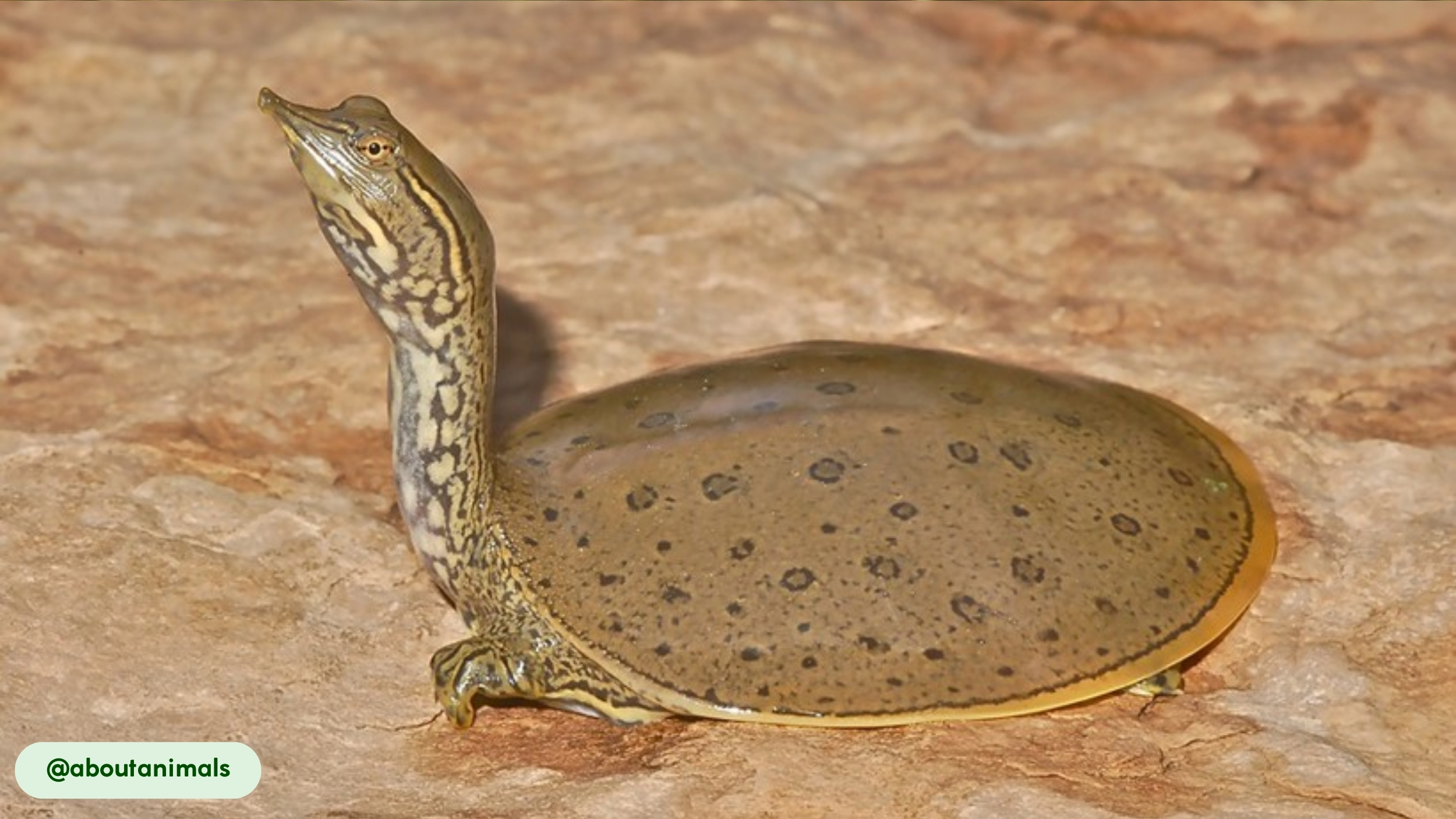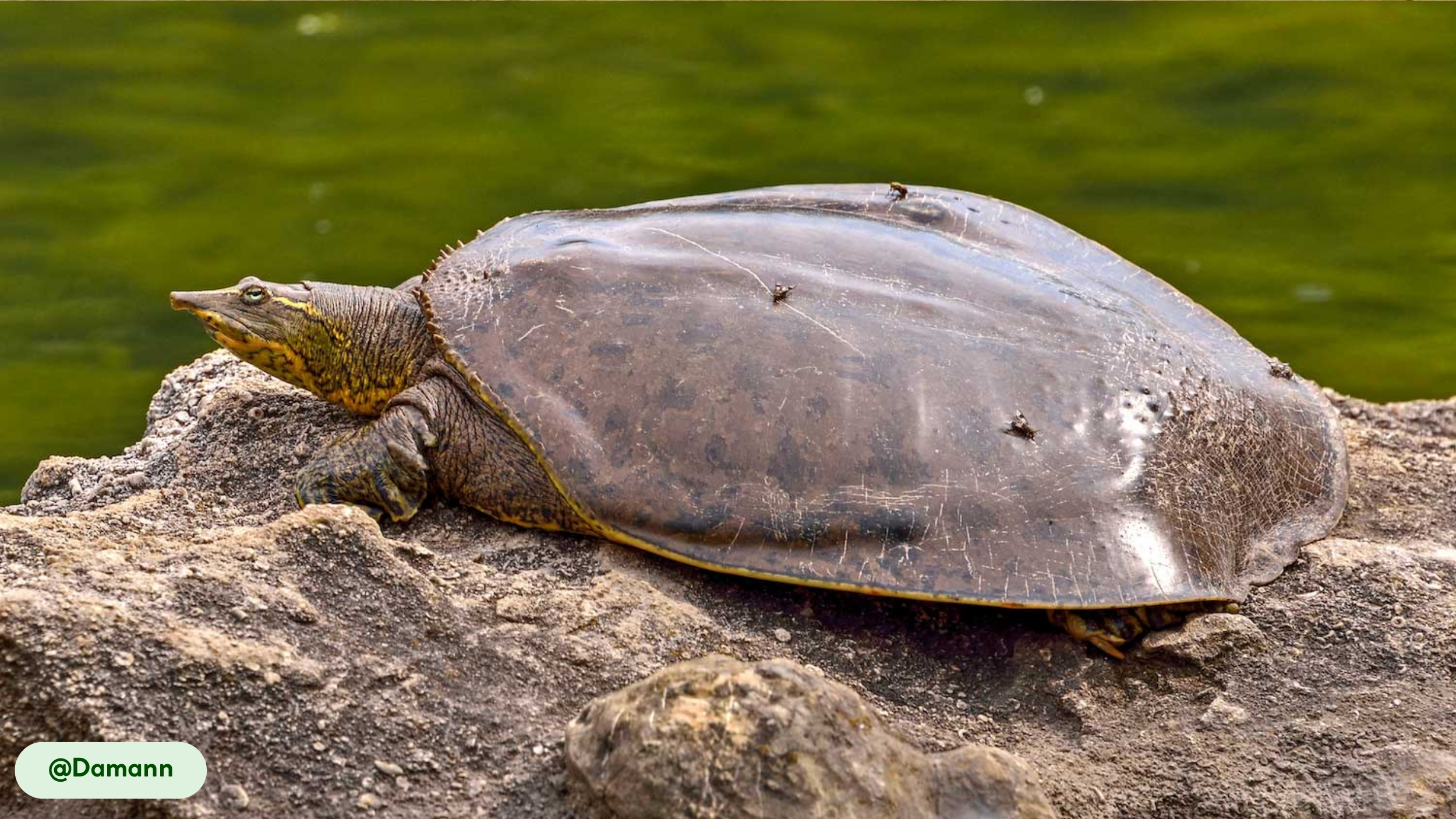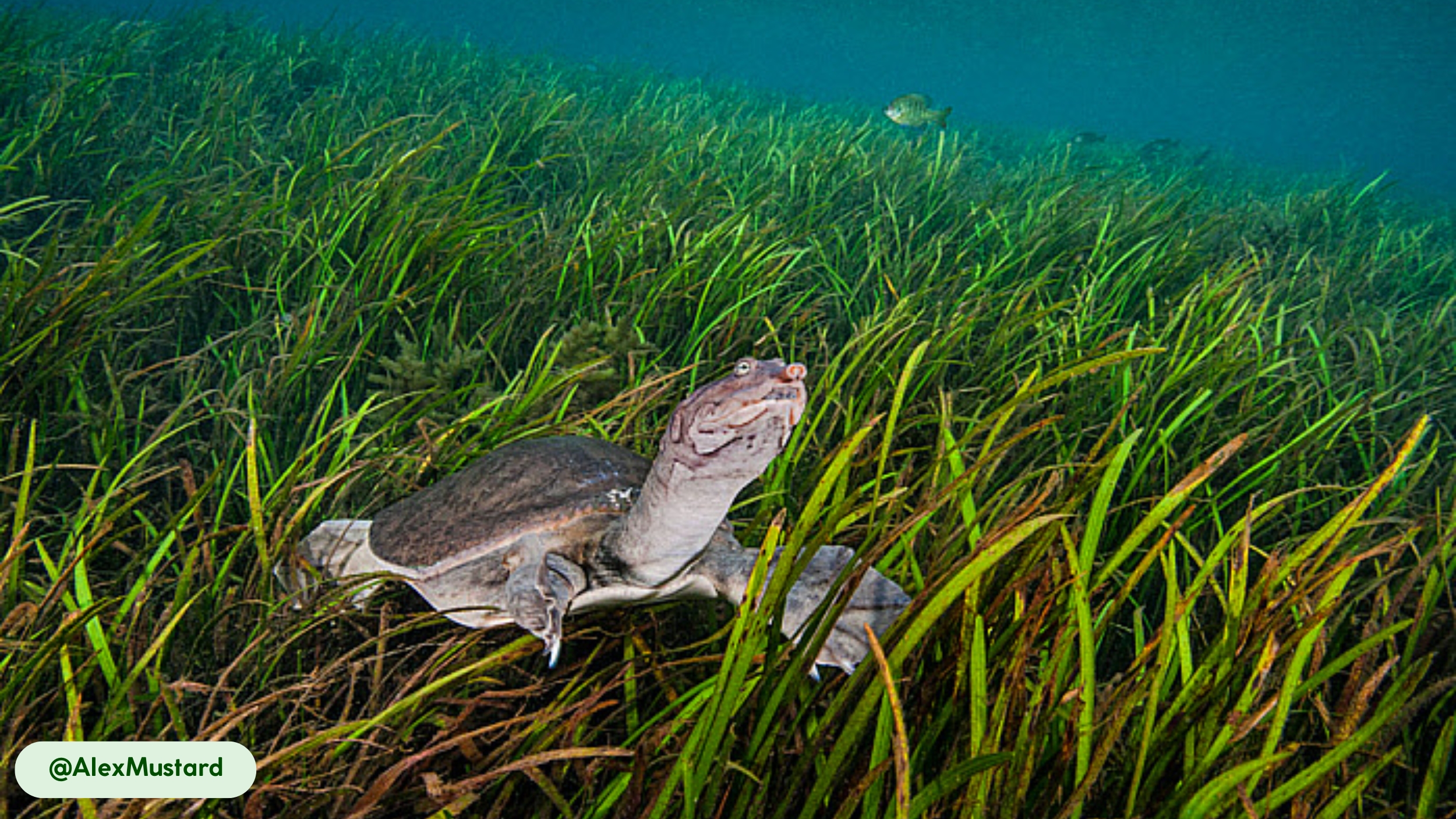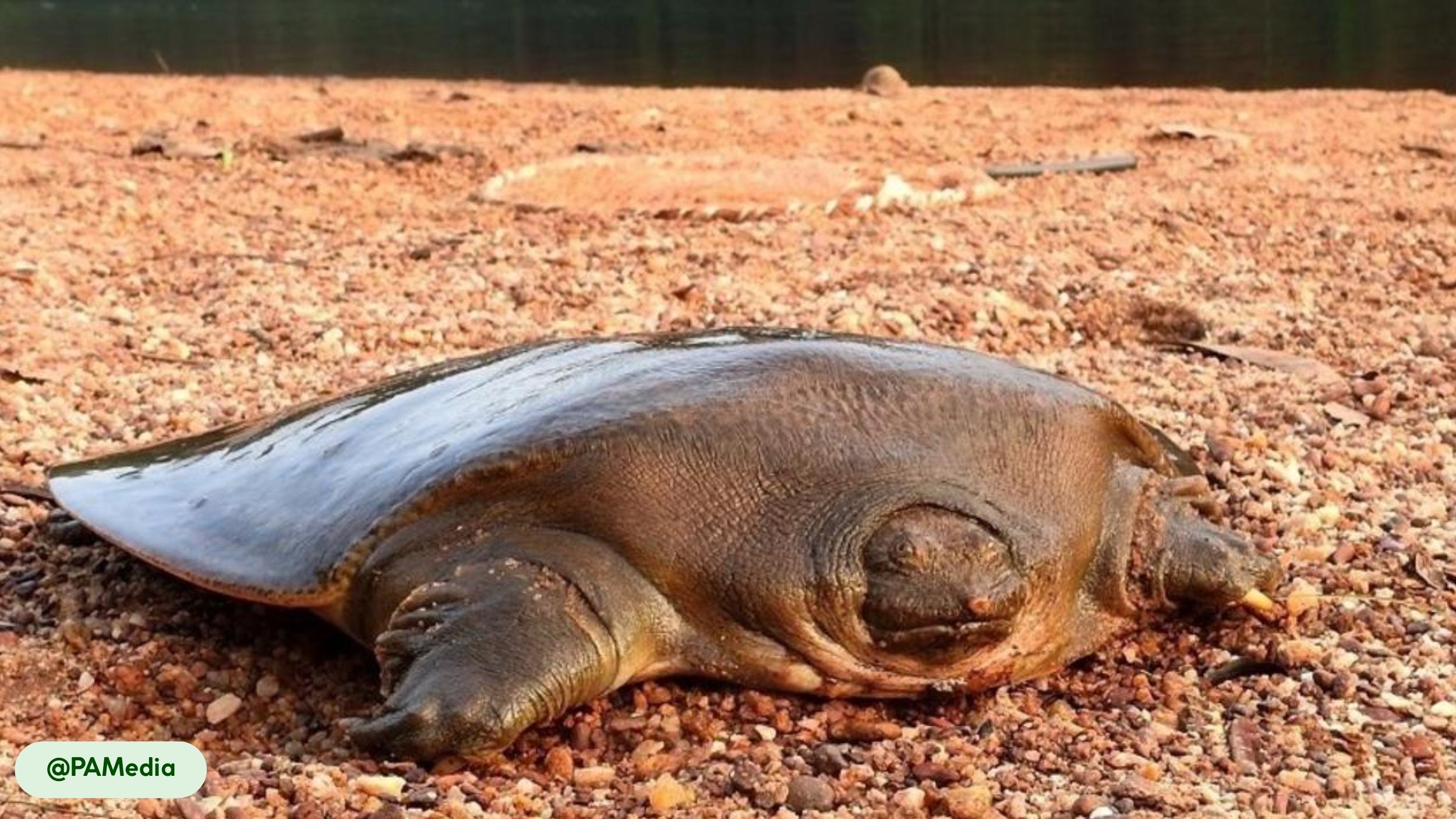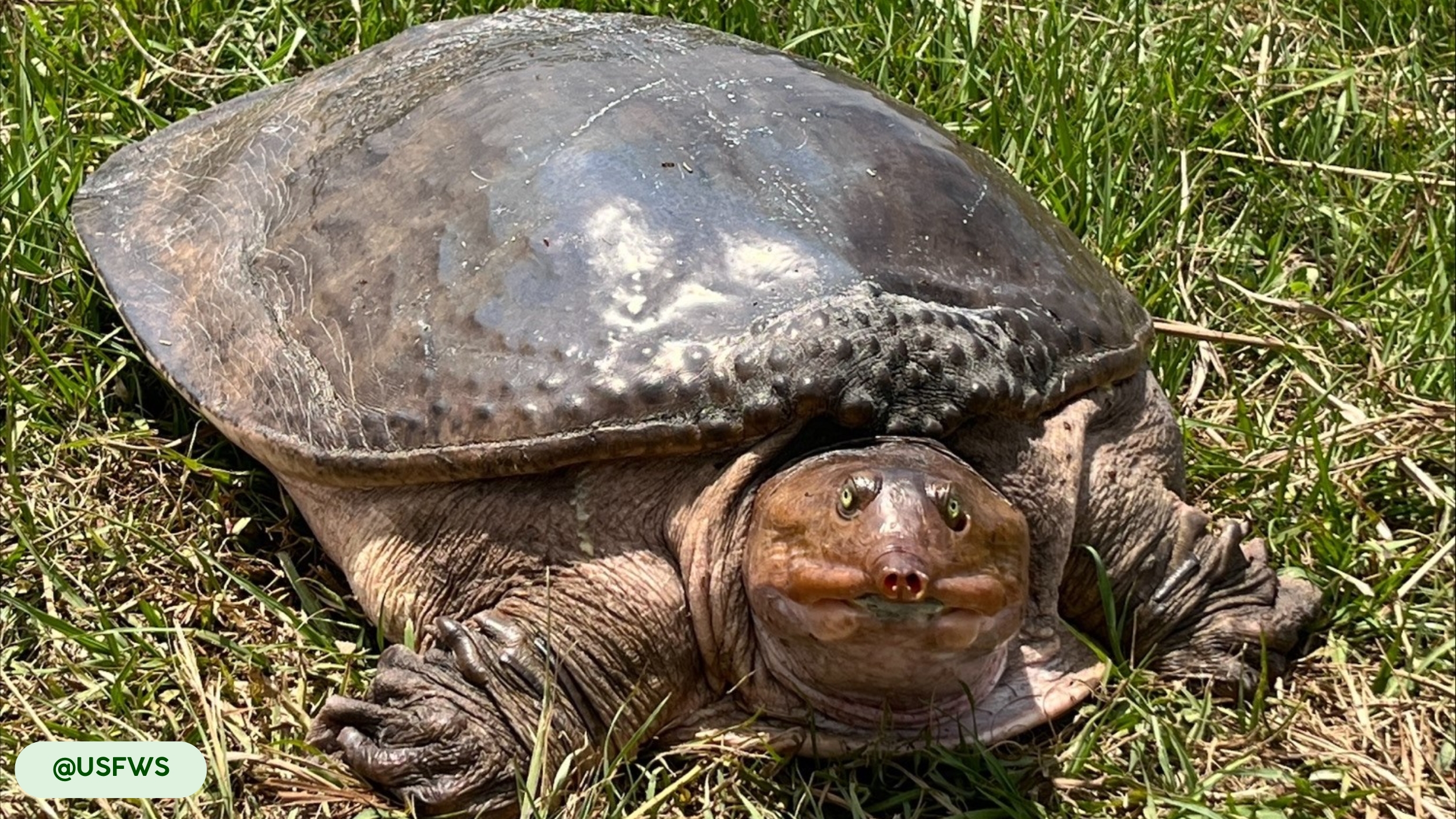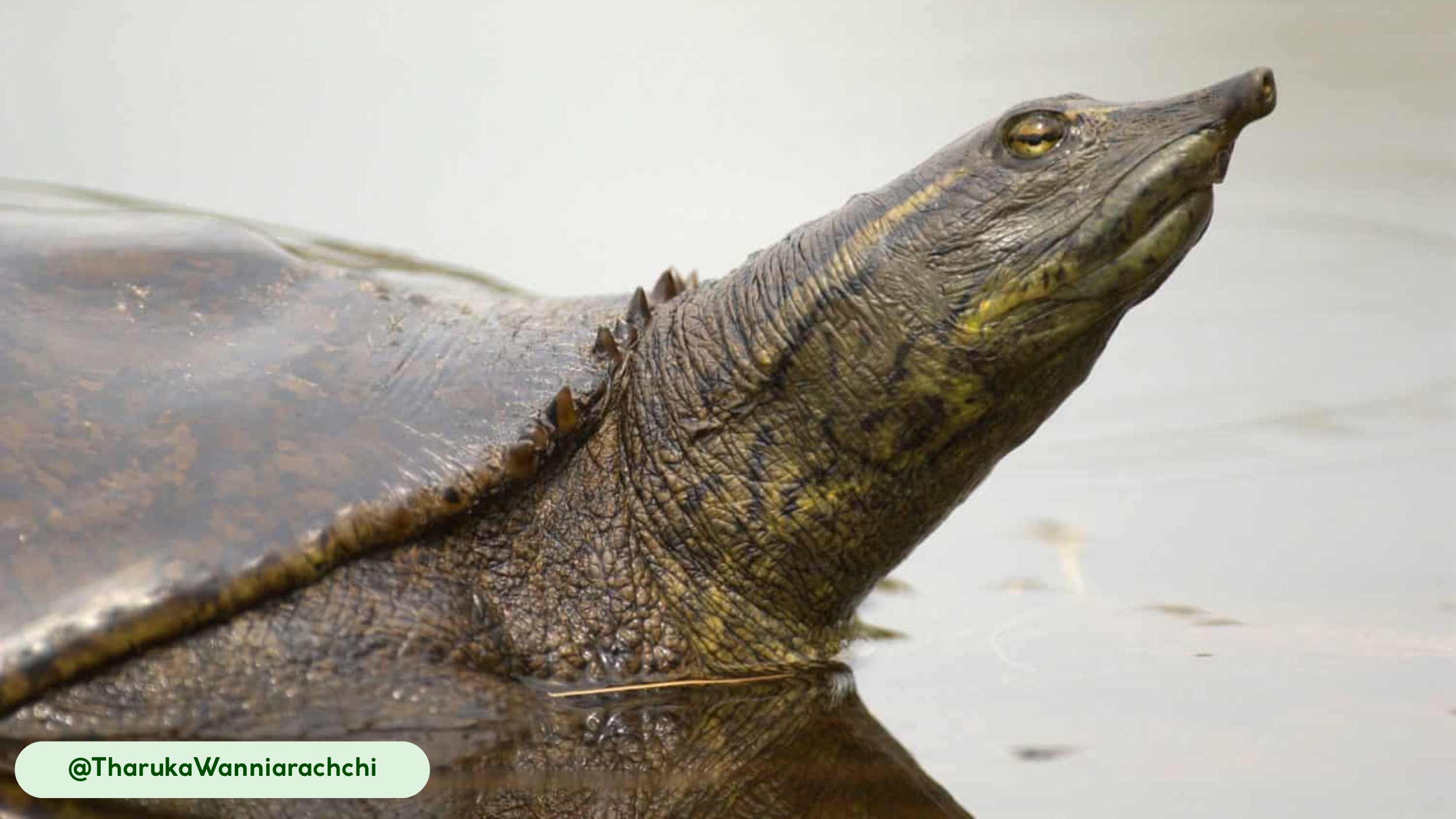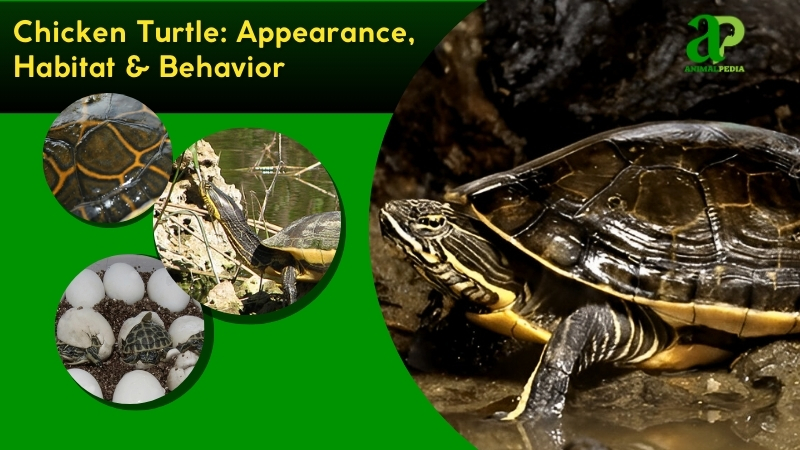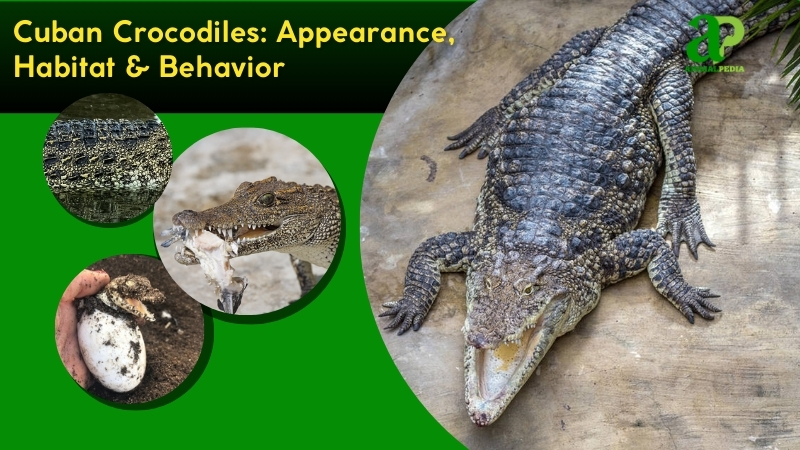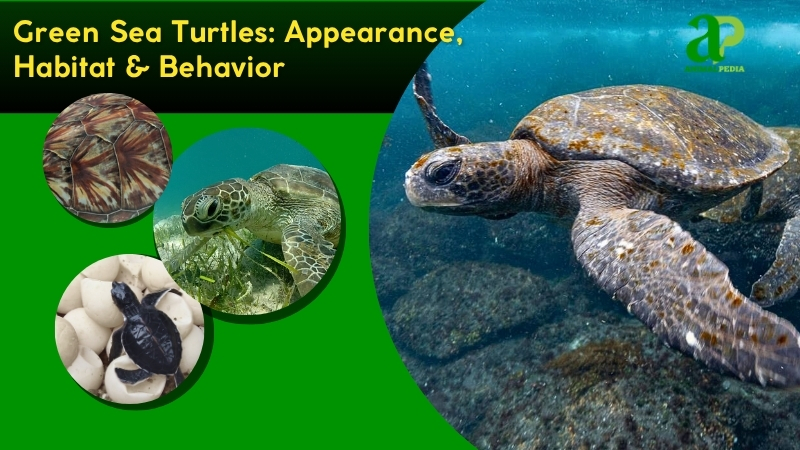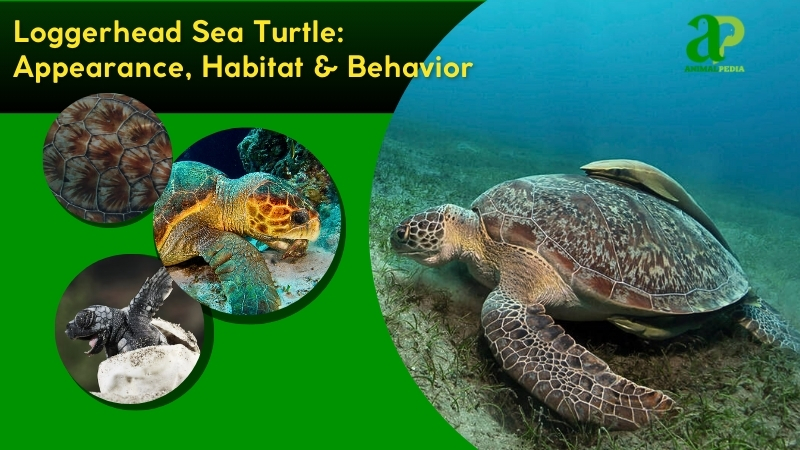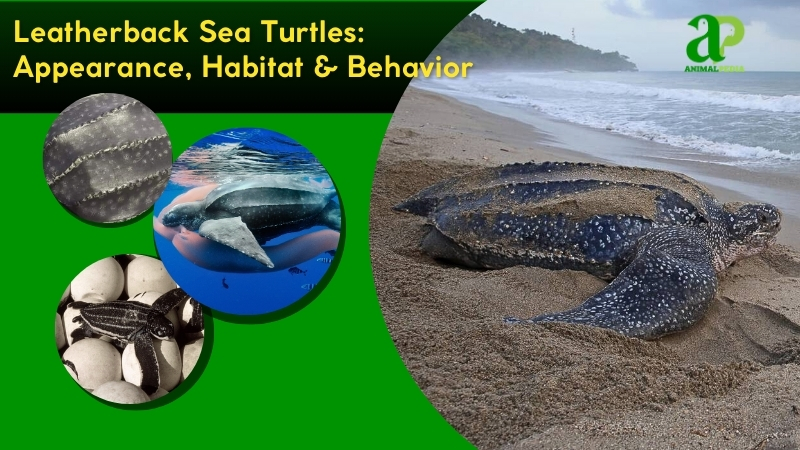Softshell turtles, belonging to the family Trionychidae, are a distinctive group of aquatic reptiles with a global distribution. They are notable for their unique morphology, including a flat, leathery carapace that lacks the bony scutes found in most other turtles, and a long, snorkel-like snout. This adaptation, alongside their webbed feet, makes them efficient swimmers and ambush predators in their freshwater habitats. A spiny softshell turtle, for example, typically measures between 13 centimeters to 54 centimeters (5 inches to 21 inches) in shell length, showcasing a wide range in size, particularly between genders. Found across continents, their diet consists primarily of aquatic insects and crustaceans.
These turtles exhibit specific daily and seasonal patterns, spending most of their time submerged, either swimming or buried in substrate. They hibernate during colder months, embedding themselves in mud at the bottom of a water body. Though many species are of “Least Concern” on the conservation scale, some regional populations face threats from habitat loss and pollution. This guide examines the defining features, behavior, and ecological significance of these fascinating reptiles, from their unique shells to their hunting prowess and beyond.

What Are Softshell Turtles?
Softshell turtles (Trionychidae) are a family of cryptodiran turtles defined by their flat, flexible carapaces covered in skin instead of rigid scutes, inhabiting freshwater ecosystems across Asia, Africa, and North America. Their classification places them within the order Testudines and the class Reptilia, with the family name Trionychidae derived from Greek words meaning “three-claws,” a reference to the three prominent claws on each foot. They are sometimes referred to by local names such as pancake turtles or pancake-shelled turtles due to their notably flat appearance. The family’s oldest fossils date back to the Cretaceous period, showing a long evolutionary history of their unique physical characteristics. Their taxonomic relatives include other freshwater turtles, but their soft, pliable shells set them apart from all other chelonians (5).
The Trionychidae family is a diverse group, with various genera and species displaying a spectrum of sizes and coloration. These turtles are primarily carnivores, employing an ambush hunting strategy. A common behavior is burying their bodies in soft sand or mud at the bottom of a river or lake, using their extended snouts as snorkels to breathe while they wait for unsuspecting prey to pass by. This unique predatory technique allows them to conserve energy while effectively hunting crayfish, fish, and other aquatic life. Their distinctive shell, which allows for greater flexibility and speed in the water, is a result of a reduction in the bony plates that constitute the carapaces of most other turtle families (2).
A turtle’s shell is its most defining trait, but what makes the softshell’s so different? We can explore the specific physical attributes that set this unique species apart from its hard-shelled cousins.
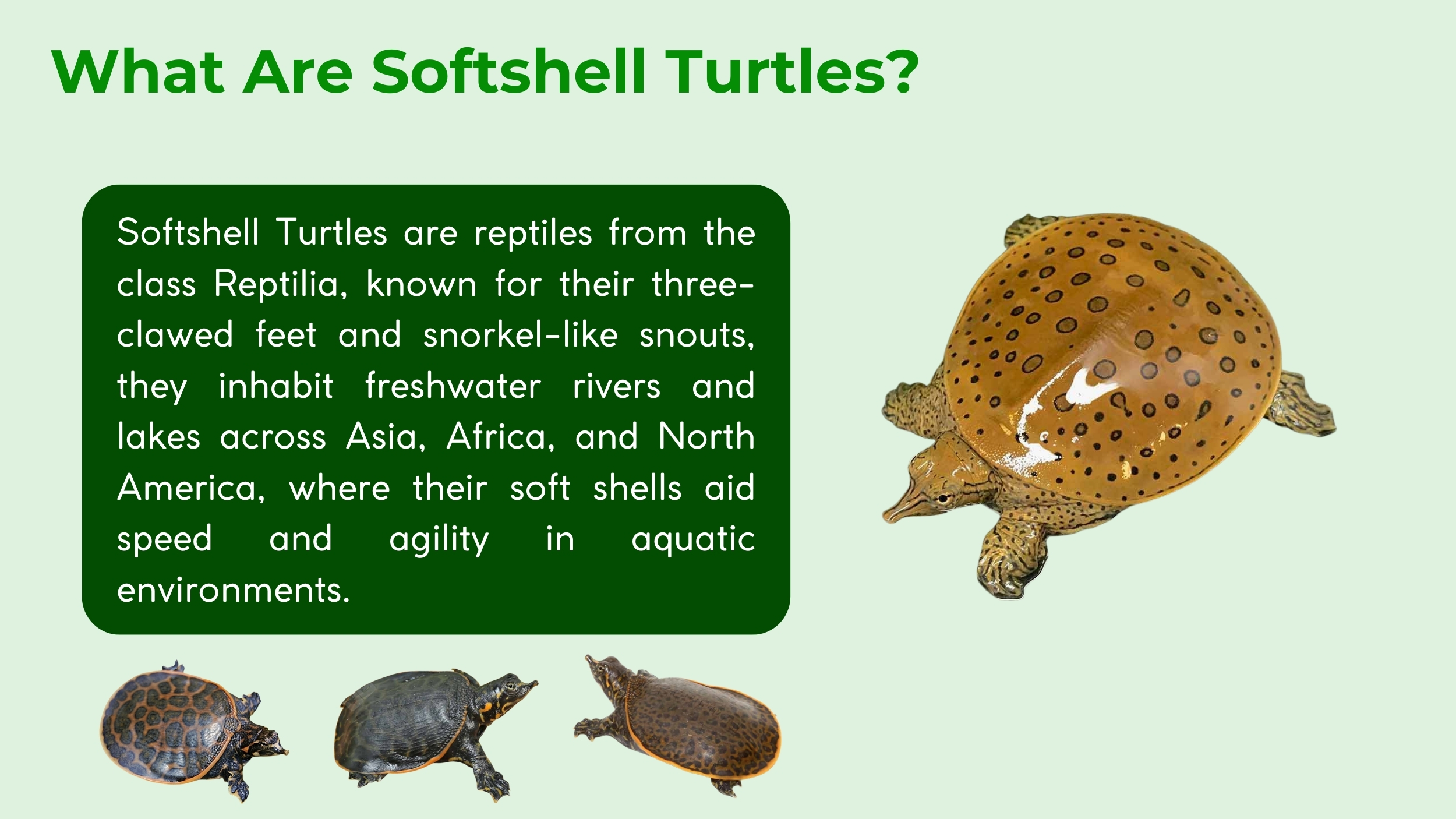
What Do Softshell Turtles Look Like?
Softshell turtles possess a body shaped for swift aquatic motion, marked by several distinct features that differentiate them from other turtles. The most defining feature is their unique shell, a flattened, almost circular carapace covered in a tough, flexible skin. Unlike the bony plates, or scutes, found on most chelonians, the softshell carapace is leathery and pliable, facilitating movement through water with minimal resistance. This morphology, combined with their pancake-like body and hydrodynamic shape, allows them to bury themselves quickly in sand or mud, making them difficult for predators to spot. Their coloration is often a pattern of olive, gray, or brown, which provides camouflage against the sandy and muddy substrates of their habitats (4).
These reptiles present five main physical characteristics that distinguish them. Each feature is an adaptation for their aquatic lifestyle.
- Leathery Carapace The flexible, skin-covered shell allows for faster swimming and permits the turtle to hide itself quickly in soft riverbeds. This shell is a reduction of the bony plates common to other turtle families (2).
- Long, Snorkel-like Snout The elongated, pointed snout is a key feature. It permits the turtle to breathe air while its entire body remains buried beneath the sand or mud, an essential tool for its ambush hunting strategy.
- Fully Webbed Feet The feet are fully webbed with three claws on each, which provides maximum propulsion for swimming and is also used for digging into the substrate.
- Powerful Jaws Their jaws are strong and sharp, designed for crushing the hard exoskeletons of crustaceans and mollusks, a primary part of their diet.
- Prominent Spines Many species, particularly the spiny softshell turtle, have small, pointed spines at the front edge of their carapace. These spines offer a final line of defense against predators.
Significant sexual dimorphism is present in their physical form. While both genders share these features, males are notably smaller, possess a longer and thicker tail, and have a cloacal opening farther from the body. Adult females, on the other hand, grow to a much larger size to accommodate the needs of reproduction and egg-laying.
While physical traits define a species, their size tells another story about their place in the world. We can next explore the impressive size range of these flat-shelled reptiles.
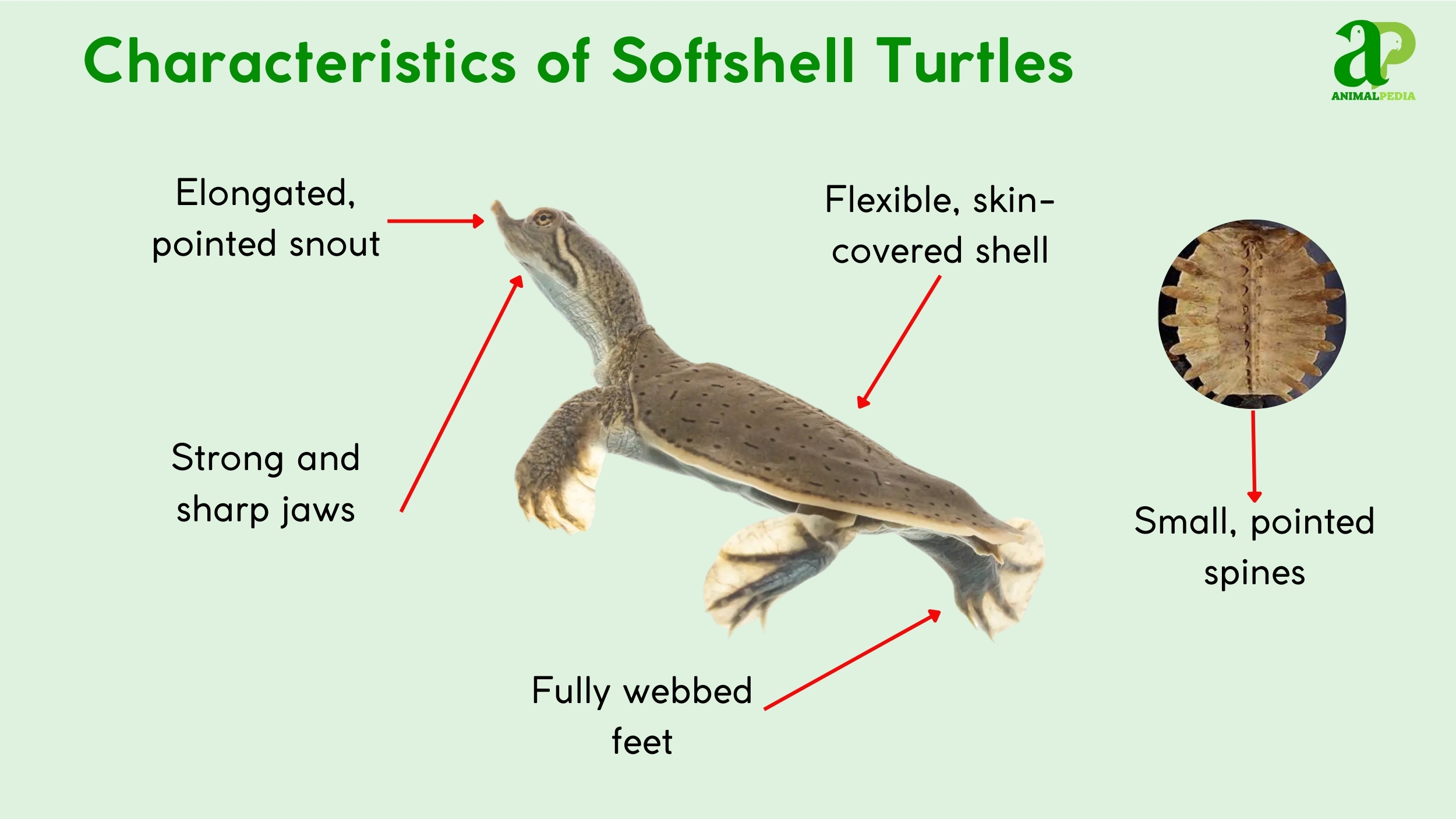
How Big Are Softshell Turtles?
The adult size of softshell turtles varies significantly by species and gender. The spiny softshell turtle, a widely recognized type, has a typical shell length of 5 to 21 inches (13 to 54 cm) with males being on the smaller end of this range. The size difference between genders is a clear example of sexual dimorphism.
| Male | Female | |
| Length | 5-9 in (13-23 cm) | 14-21 in (35-54 cm) |
| Weight | 1-2 lbs (0.5-1 kg) | 11-26 lbs (5-12 kg) |
| Record Size | N/A | 30.7 lbs (13.9 kg) |
Softshell turtles begin life as small hatchlings, often measuring only 1.25 inches (3 cm) in diameter. These tiny juveniles grow steadily, eventually reaching their adult sizes. An adult female can reach a size comparable to a dinner plate, while a mature male may be similar to a small hand-held frying pan.
A turtle’s home determines much of its behavior and survival. We can next investigate the specific habitats where softshell turtles thrive and what their environment reveals about them.
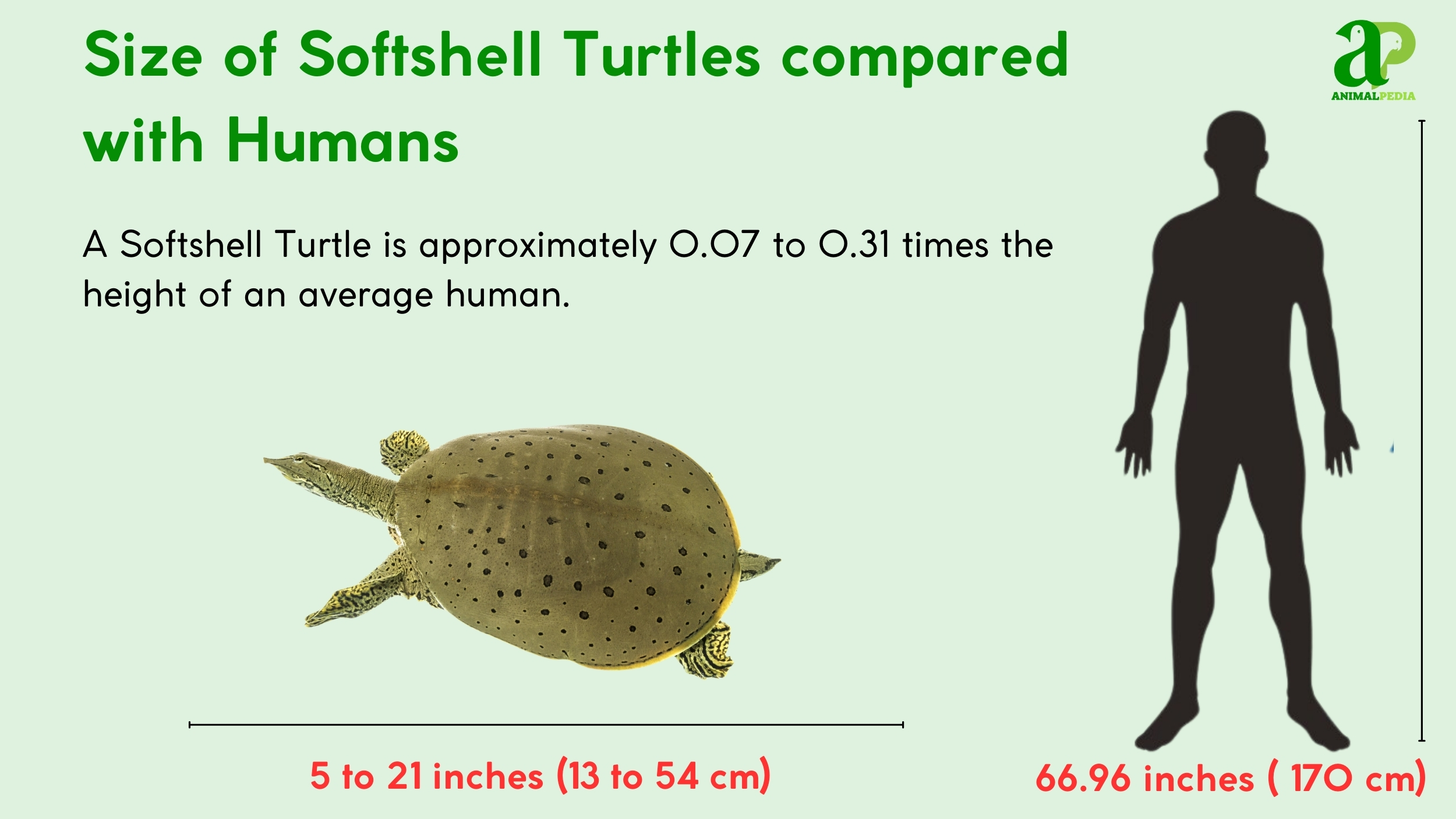
Where Do Softshell Turtles Live?
Softshell turtles are found in a wide variety of freshwater environments across continents, with native populations established in North America, Asia, and Africa. Their distribution includes lakes, rivers, streams, and ponds. They require habitats with soft, sandy, or muddy bottoms where they can easily bury themselves to escape predators or ambush prey (7). These species favor warm, temperate, and tropical climates.
Within their chosen habitats, these turtles occupy specific ecological niches. They typically remain in shallow waters, often at depths of less than 3 meters (10 feet), preferring areas with minimal vegetation and abundant substrate for burrowing. Their movements are often confined to a specific home range, which they use for foraging and basking (7). Some adult males can be territorial, defending a small area to ensure access to food resources.
Living in these environments shapes a turtle’s behavior in profound ways. We can now explore the fascinating behaviors and abilities that softshell turtles have developed for survival.
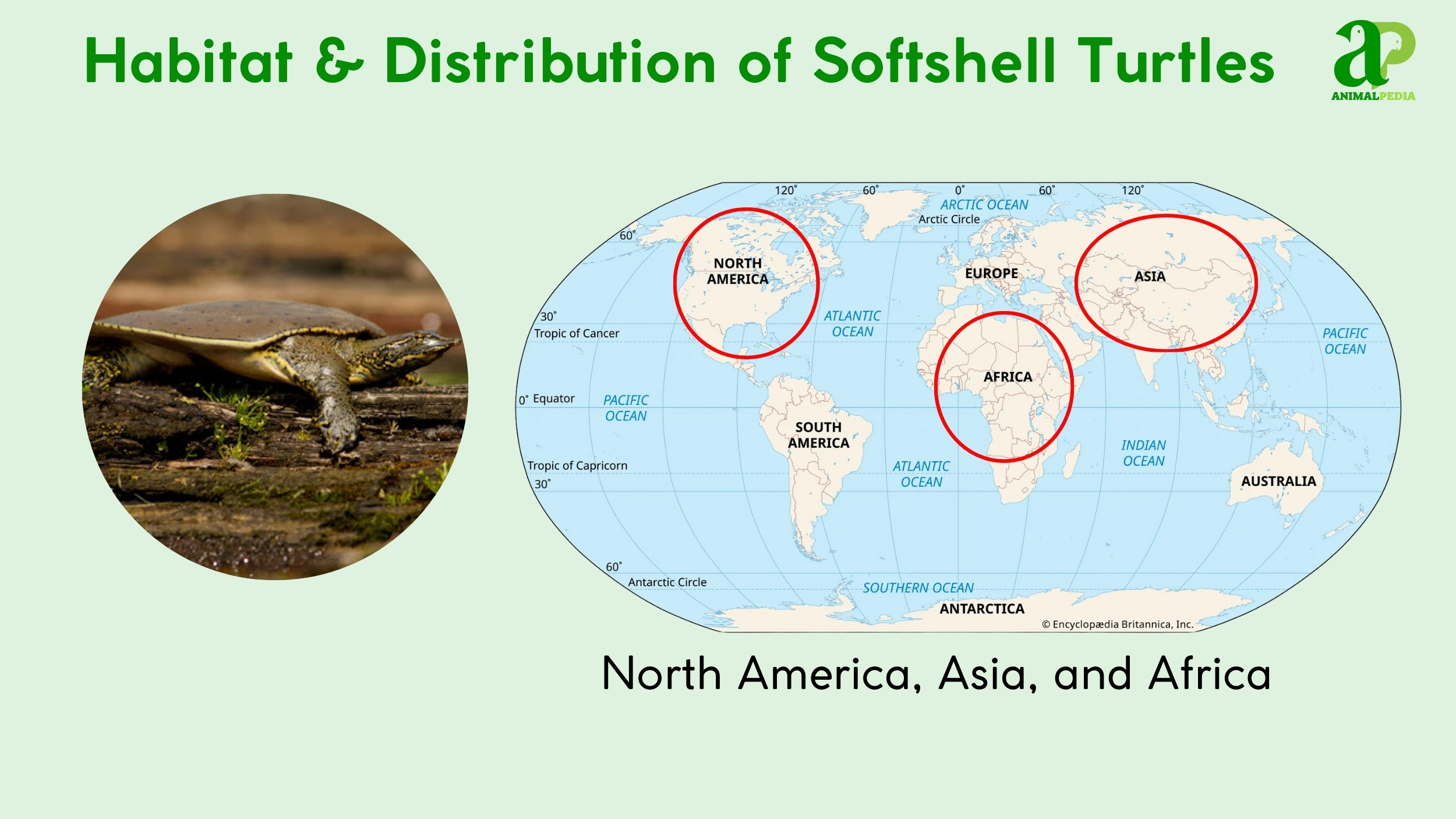
How Do Softshell Turtles Behave?
Softshell turtles are a dynamic group of reptiles, characterized by a highly active and predatory lifestyle. Their behaviors are finely tuned for life in freshwater habitats. These turtles are primarily active during the day, focusing on hunting, basking, and exploring their aquatic environments. Their behaviors can be summarized in three main categories:
- Diet and Feeding Softshell turtles are carnivorous, using an ambush strategy to capture prey from their submerged positions in the substrate.
- Movement and Abilities They are powerful, fast swimmers and also possess the unique ability to breathe through their skin in addition to their snorkel-like snouts.
- Daily/Seasonal Patterns Their activity is primarily diurnal, and they spend the colder months in a state of brumation, buried in the mud.
Their behavior is defined by their unique eating habits. To understand these reptiles fully, we can first examine their carnivorous diet and hunting strategies.
Diet and Feeding
Softshell turtles are carnivores that consume a variety of prey, with a diet that includes aquatic insects, crayfish, and fish. A study on the spiny softshell turtle revealed that crayfish and aquatic insects constitute a significant portion of their diet, indicating their role as important aquatic predators (11). Their hunting behavior is characterized by an ambush strategy, where they bury themselves in the substrate with only their snorkel-like snout exposed. When prey moves nearby, they strike with a sudden, rapid lunge. This predatory method is energy-efficient and highly effective. Special adaptations, such as their powerful jaws and beak-like mouths, are designed to crush the shells of their hard-bodied prey, highlighting their specialized feeding habits.
While their hunting is a spectacle, their interactions with humans are a separate matter. We can now consider the question of whether softshell turtles pose a danger to people.
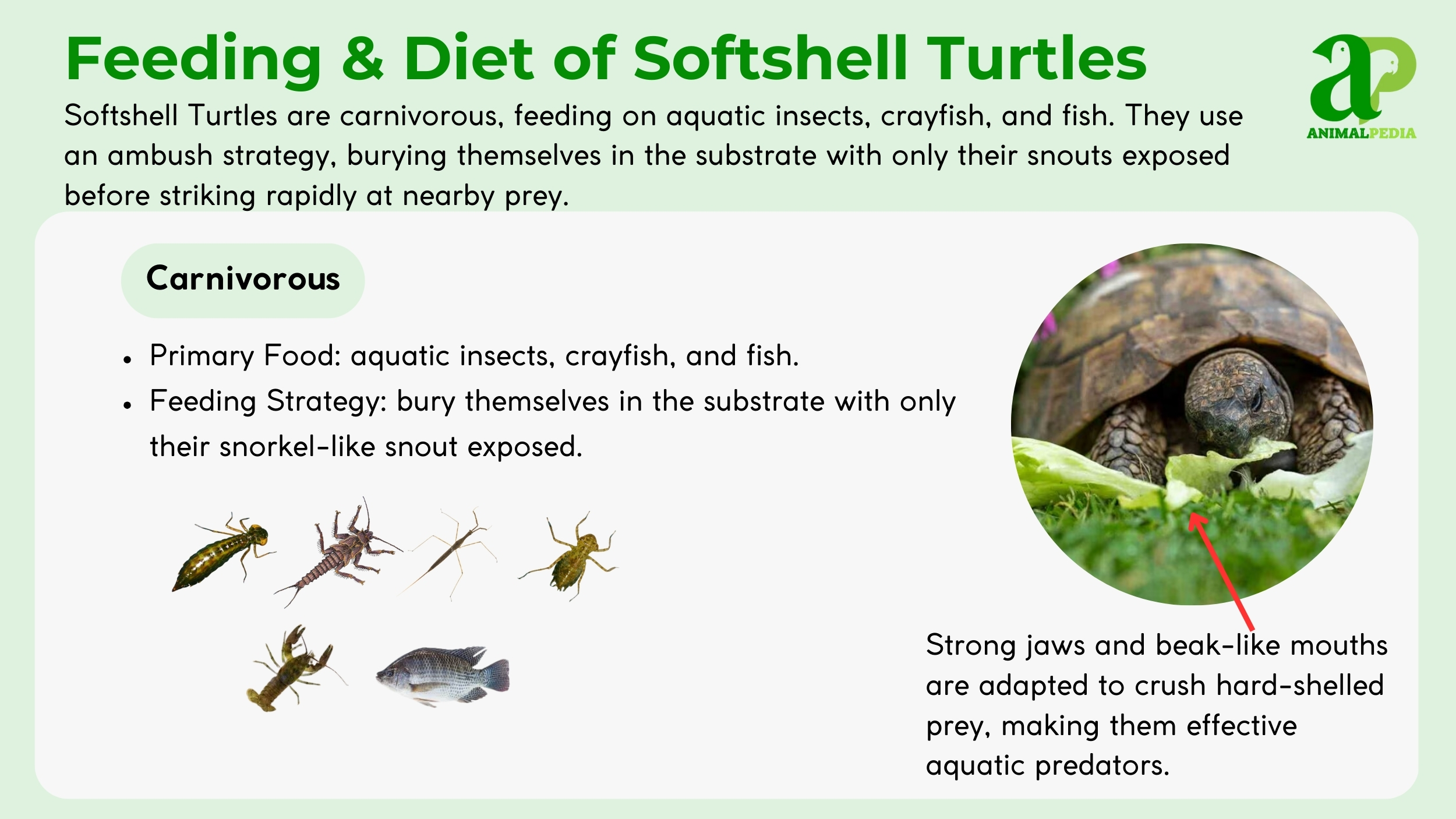
Are Softshell Turtles Dangerous?
Softshell turtles are not venomous; their primary danger to humans is their powerful bite. They are known for their speed and agility, which can be surprising to an unsuspecting person. A bite from a softshell turtle can be painful and may cause significant injury due to their sharp beak and strong jaw muscles. Research has shown that their bite force is directly related to their crushing of hard-shelled prey (4). When encountered, these turtles will typically retreat to the water. However, if they feel cornered or threatened, their defensive reaction is to bite. Guidelines for encountering softshell turtles include observing them from a distance and avoiding handling them to prevent a defensive bite.
Beyond their biting capabilities, softshell turtles possess an array of physical abilities that make them masters of their aquatic environment. We can now explore how they navigate and survive in their world.
Movement and Abilities
Softshell turtles move with remarkable speed and grace in their aquatic habitats. Their flattened, streamlined bodies and fully webbed feet make them highly effective swimmers. In water, they can propel themselves with bursts of speed to catch prey or escape danger. On land, their movement is limited, often reduced to a shuffling gait, although they can move surprisingly quickly when necessary, especially to reach a nesting site. A unique ability of some species, such as the spiny softshell, is the ability to breathe through their skin while submerged, an example of cutaneous respiration. This allows them to remain underwater for extended periods without needing to surface, a critical advantage for their ambush hunting style.
A turtle’s daily life is a constant cycle of activity and rest. Next, we can look at the daily and seasonal patterns that define their existence.
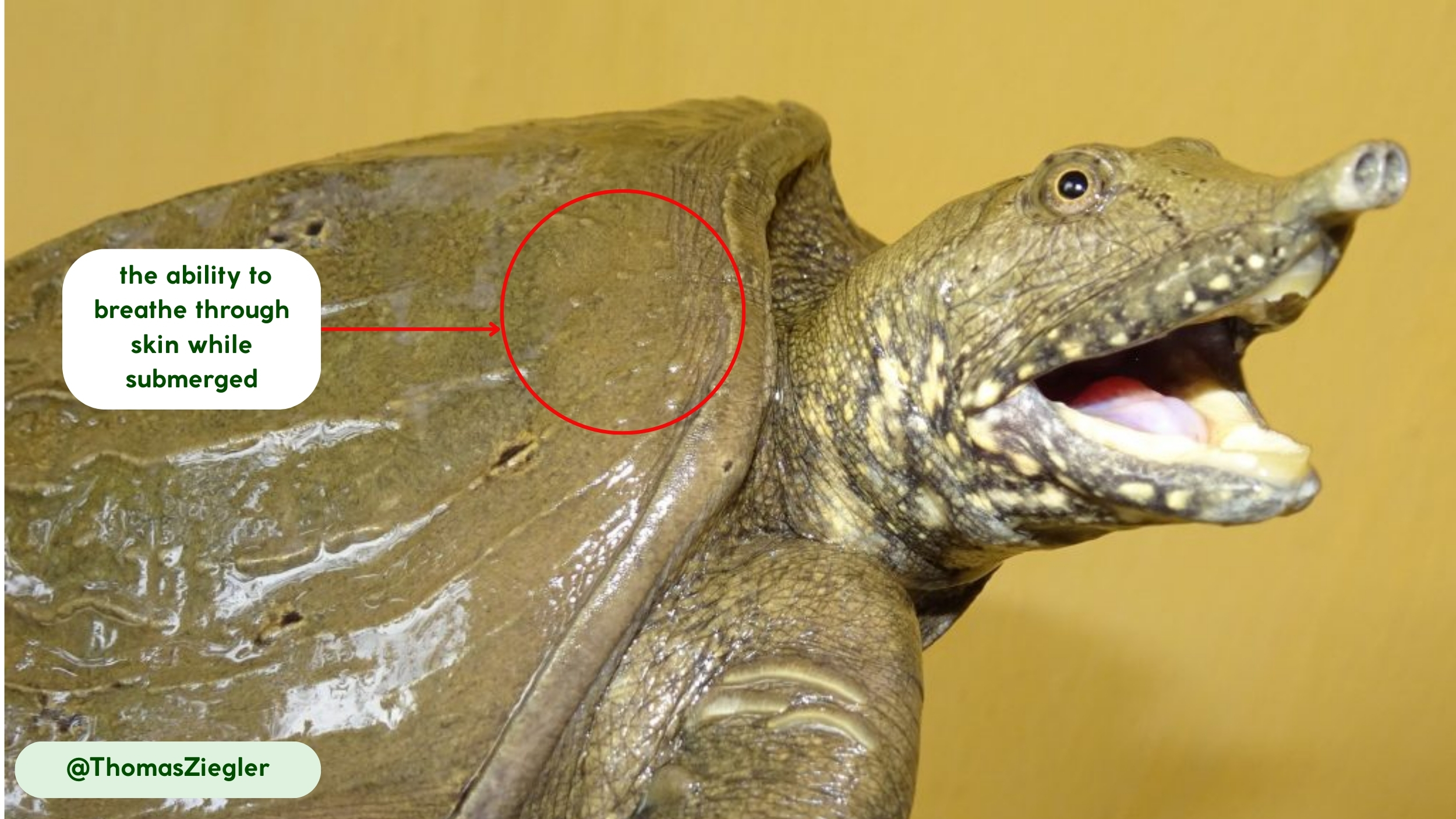
Daily/Seasonal Patterns
Softshell turtles are most active during the day, with their activity driven by the need for thermoregulation and foraging. Their activity cycle is closely tied to environmental temperatures. They typically begin their day by basking in the morning to raise their body temperature before moving into the water to hunt and forage during mid-day. Their activity then slows as the afternoon progresses, at which point they seek out resting spots (12).
Activity levels peak during warmer months, from late spring through early autumn, as warmer temperatures allow for increased metabolism and energy for foraging. During winter, when temperatures fall, they enter brumation, a period of inactivity where they bury themselves deep in the mud at the bottom of a water body (12). These turtles do not undertake long-distance migrations, with their movements typically limited to their home range or short distances between connected bodies of water for nesting or to find new foraging grounds (7).
With their daily routines understood, a natural next step is to examine their reproductive process and how they continue their lineage.
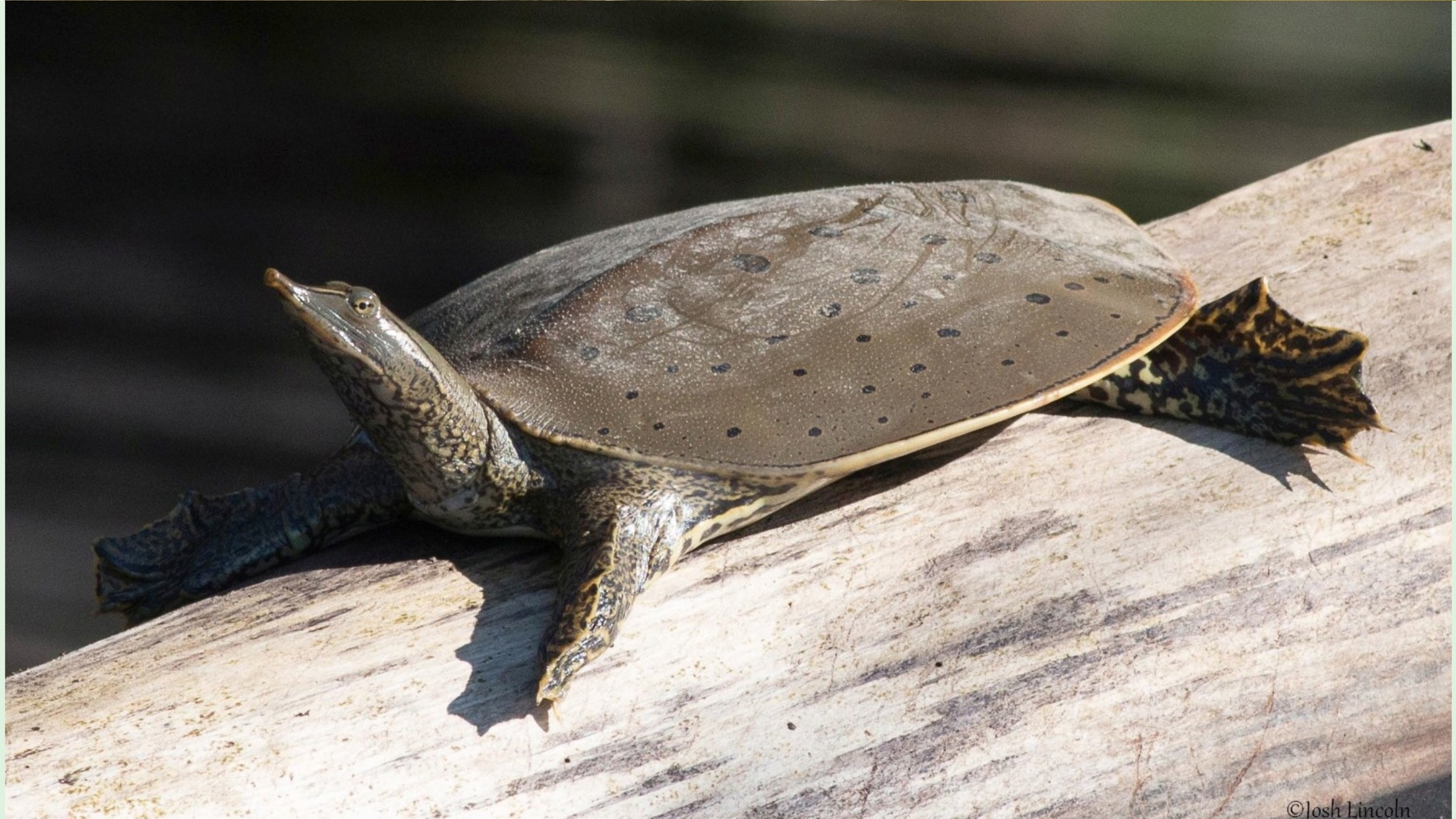
How Do Softshell Turtles Reproduce?
Softshell turtles reproduce through oviparity, a process of laying eggs. Mating typically occurs in the water during early spring. Courtship behaviors involve a male pursuing a female, sometimes with tactile stimulation to the female’s shell or limbs (1). Once receptive, the female permits copulation, after which she stores the male’s sperm for later use. Females emerge from the water to build nests in sandy or soft soil near the shoreline. The female excavates a flask-shaped hole where she deposits a clutch of eggs. The number of eggs varies widely by species and size, ranging from 4 to 32 eggs. The incubation period can last up to 100 days, after which the hatchlings emerge and are fully independent, with no parental care provided.
The reproductive cycle is an important part of a turtle’s life. This leads us to another key aspect of their life story: their lifespan and how it compares to other species.
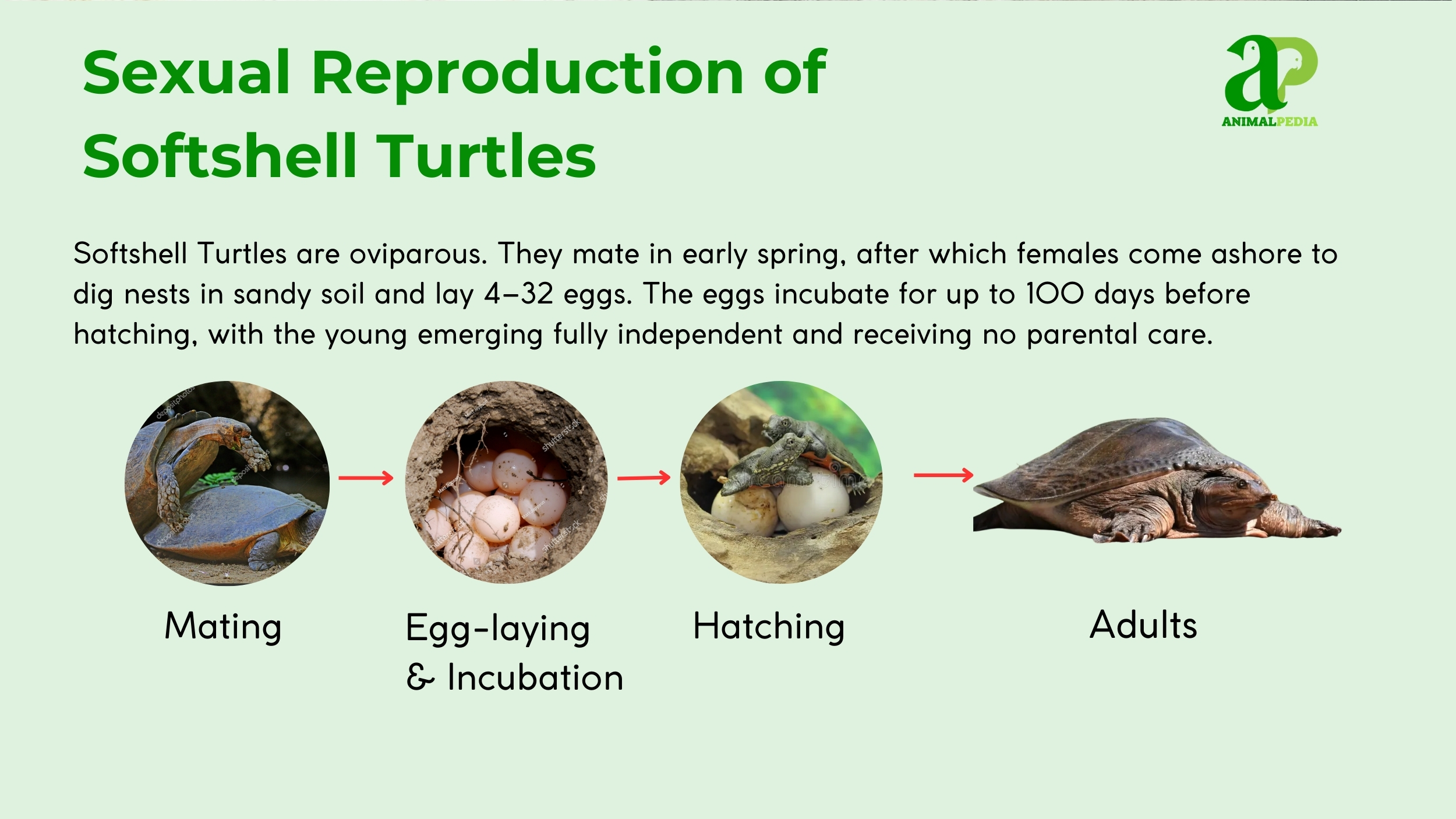
How Long Do Softshell Turtles Live?
Softshell turtles can live for a long time. In the wild, they typically live around 25 to 30 years on average. In captive environments with proper care, their lifespan can extend significantly, sometimes exceeding 50 years (8). This difference highlights the impact of predation, disease, and habitat quality on their longevity. Sexual maturity is reached at varying ages. Males mature between 8 to 10 years, while females mature slightly later, at around 10 to 12 years. Their lifespan depends on several factors, including the quality of their food source, the health of their habitat, and the presence of human-related threats like pollution or habitat destruction.
Longevity is a testament to their resilience. It also brings us to a question about their relationship with people. Are these animals of benefit to the human population?
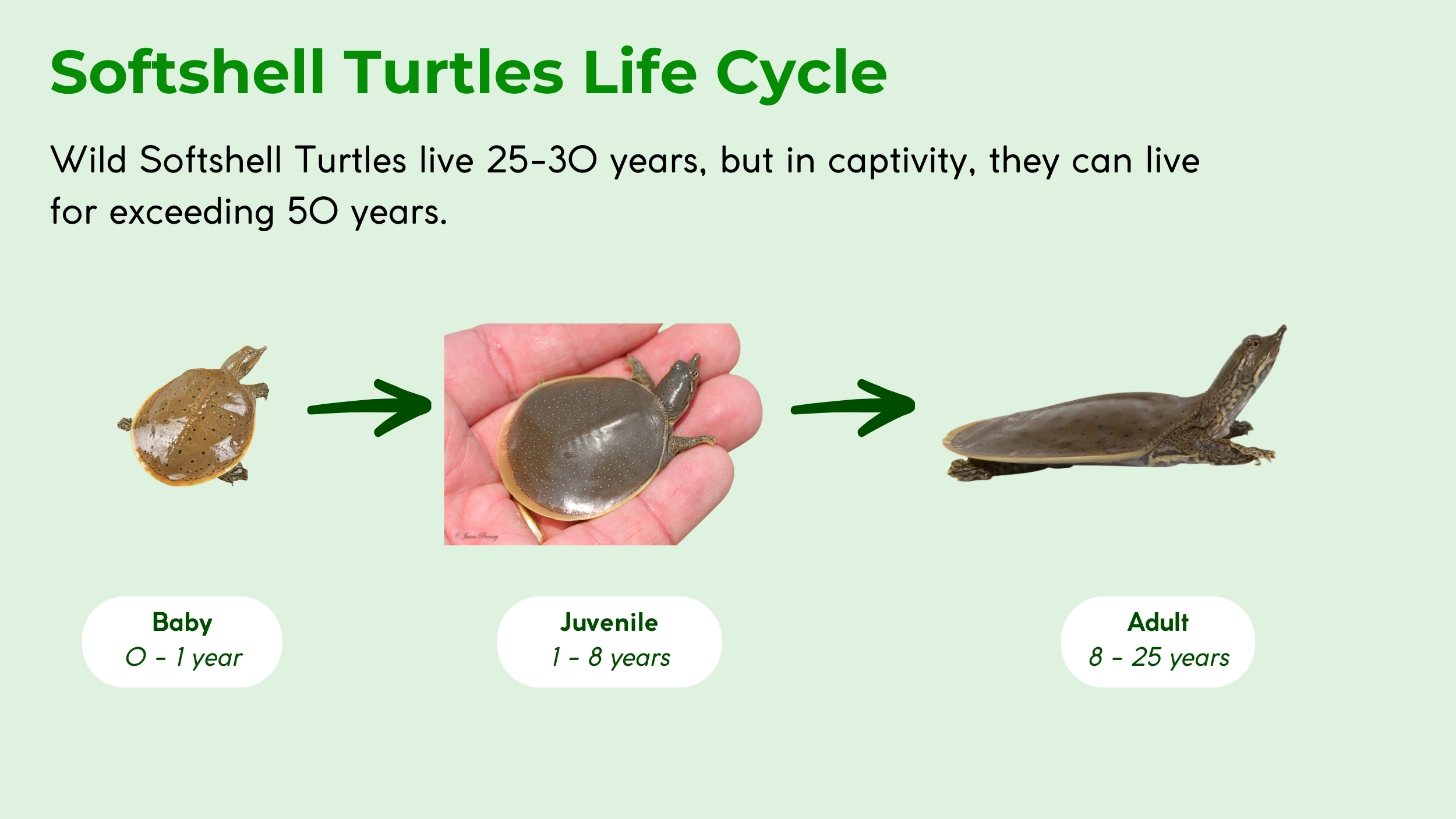
Are Softshell Turtles Beneficial to Humans?
Softshell turtles are beneficial to humans primarily through their ecological roles. As aquatic predators, they maintain the health of freshwater ecosystems by controlling populations of insects, crustaceans, and fish (9). This ecological function helps to balance the food web. In certain cultures, some species are collected for consumption or used in traditional medicine, providing a food source. However, their contribution to the human diet is secondary to their vital role in maintaining balanced aquatic environments.
Their potential danger to humans is limited to a defensive bite. The snapping force of these turtles can cause injury, a behavior they exhibit when they feel threatened (4). Public safety guidelines recommend observing these animals from a distance. The only other direct interaction is a limited practice of keeping them as pets, which requires specialized knowledge due to their size and specific care needs.
Their relationship with humans brings up a related topic of concern: conservation. We can next consider how human actions affect these creatures and what their current conservation status is.
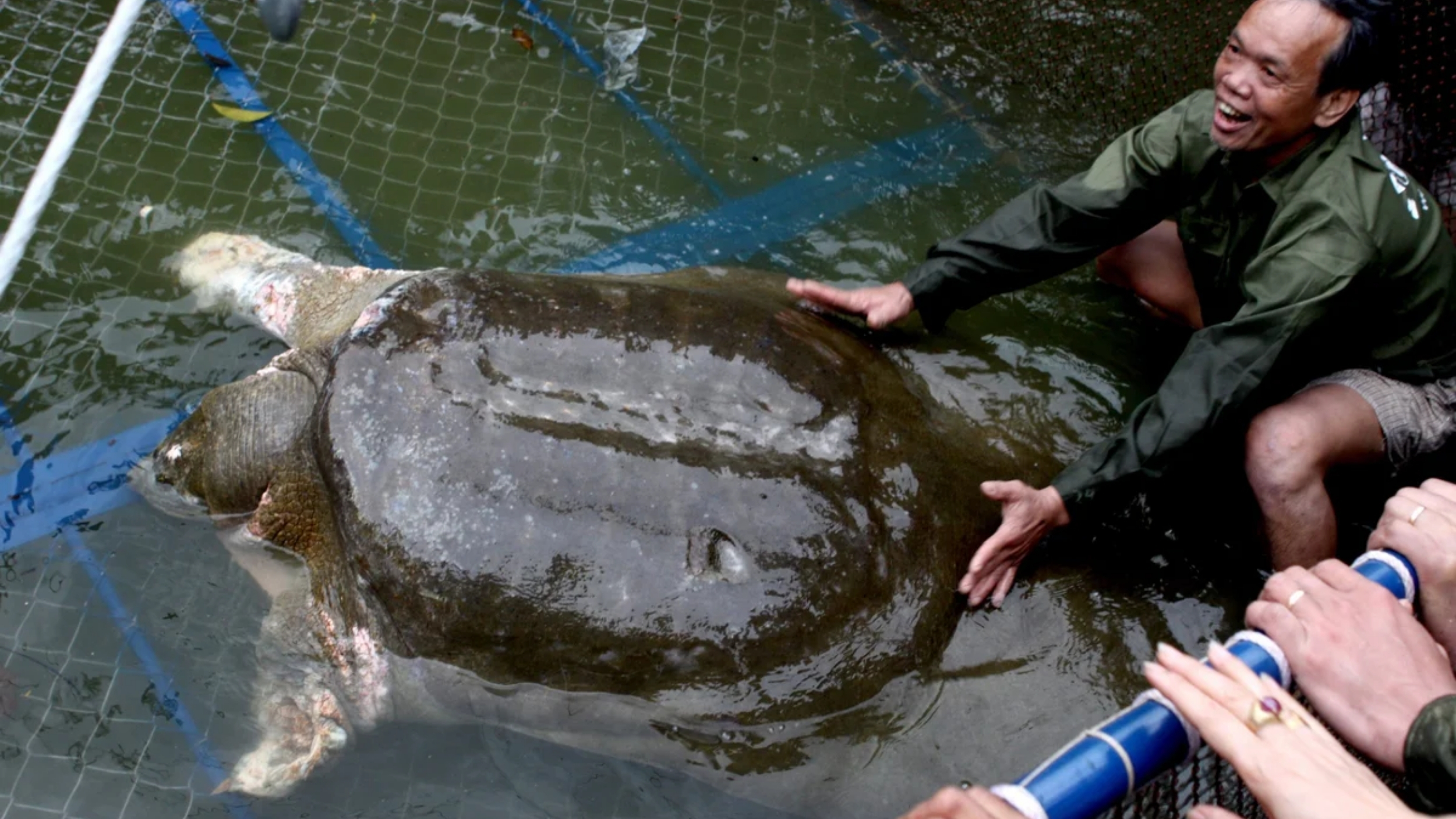
Are Softshell Turtles Endangered?
The conservation status of softshell turtles is complex, with some species facing significant threats while others are stable. On the IUCN Red List of Threatened Species, the majority of softshell turtle species are categorized as “Least Concern” (6). However, a few species, such as the Cantor’s giant softshell turtle (Pelochelys cantorii), are listed as “Critically Endangered” (6). The main threats to their survival include habitat destruction, particularly from damming and pollution, and over-collection for the food and pet trades (7).
These reptiles are important to their ecosystems. As apex predators in many freshwater habitats, they play a crucial role in regulating populations of their prey, which maintains a balanced food web (9). To help with their survival, people can support local conservation projects, protect and restore wetland habitats, and avoid the illegal pet trade. By understanding their ecological importance, we can help protect both the common and the most vulnerable softshell turtle species.
With their conservation status in mind, a deeper understanding of these animals is gained through a collection of surprising details. We can now explore a series of fascinating facts that highlight their unique nature.
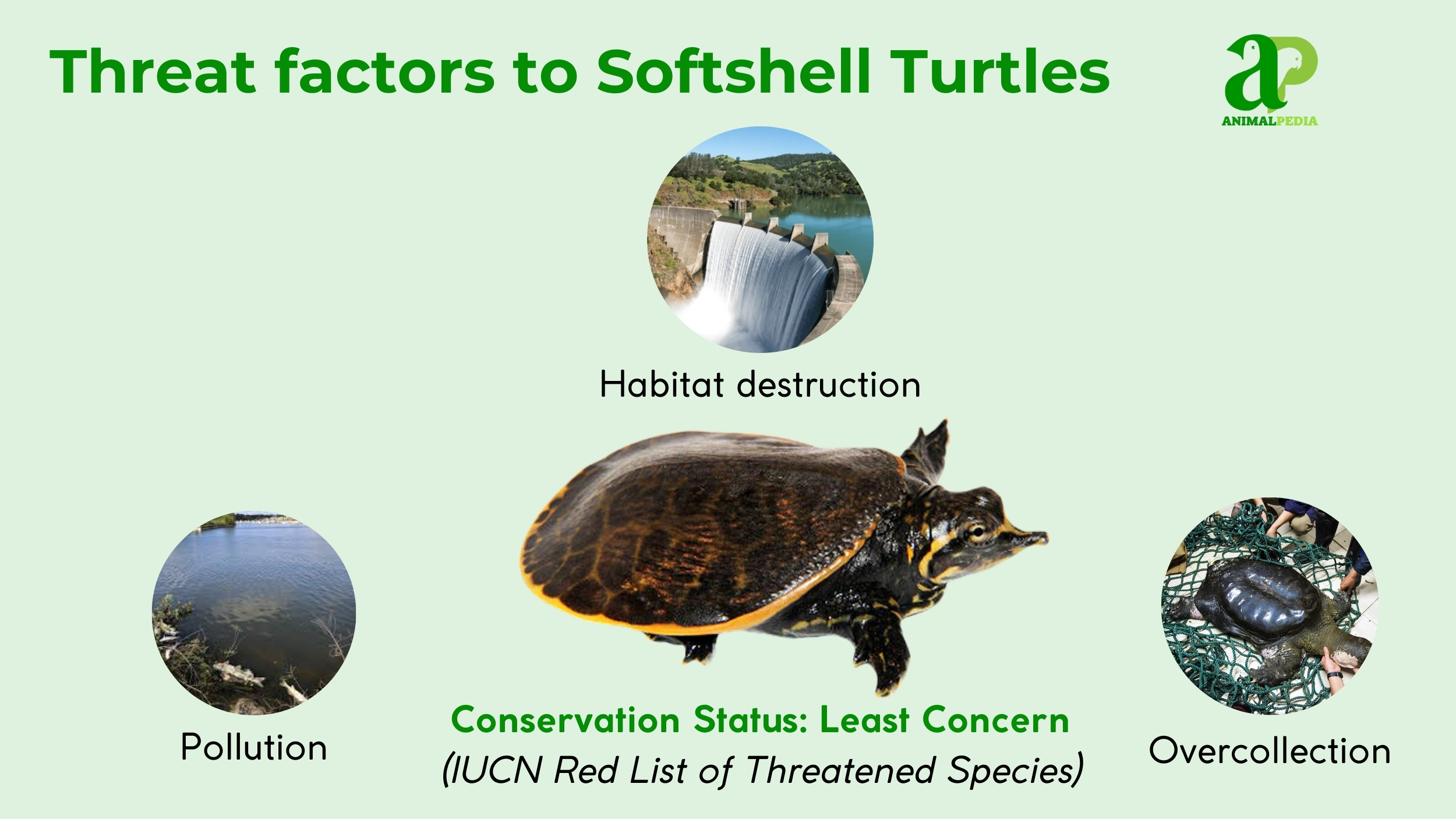
Frequently Asked Questions About Softshell Turtles
Do Softshell Turtles Bite?
Yes, softshell turtles have powerful jaws and can deliver a painful bite as a defensive mechanism. They are not venomous, but their ability to snap with surprising speed is a direct threat to any person who handles them without expertise (4).
Do Softshell Turtles Need A Basking Area?
Yes, basking is vital for softshell turtles. They use basking to regulate body temperature, aid in digestion, and absorb ultraviolet light for shell health (12). Their activity cycle is closely tied to environmental temperatures.
How Many Softshell Turtles Are Left In The World?
The exact number of softshell turtles is not known. The conservation status of softshell turtles varies by species. Some species are of “Least Concern,” while others, like the Cantor’s giant softshell turtle, are “Critically Endangered” (6).
Are Softshell Turtles Good Pets?
Softshell turtles are not ideal pets for beginners. They grow to a large size, require specialized care and diet, and can have an aggressive demeanor. This makes them a more suitable pet for a knowledgeable reptile keeper.
Are Softshell Turtles Poisonous?
No, softshell turtles are not poisonous. They are not venomous either. Their only danger to humans is a defensive bite, which can be quite painful due to their strong jaw muscles and sharp beak.
Conclusion
The softshell turtle is a fascinating example of evolutionary adaptation, showcasing unique physical traits and behaviors for survival in freshwater habitats. Their soft, leathery shell and distinctive snout make them standout members of the reptile family. From their predatory ambush style to their impressive longevity, these creatures play an important role in the global ecosystem. To continue your journey into the world of wildlife and discover more about the animals that share our planet, explore the comprehensive resources available at Animal Pedia. Our mission is to provide an immersive and scientifically accurate experience for all animal enthusiasts.

